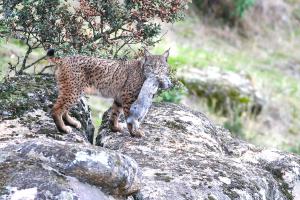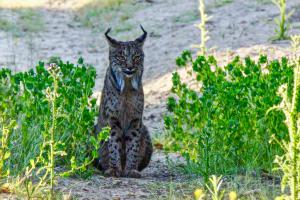Iberian lynx – Europe’s Conservation Success Story
The Iberian lynx, the rarest cat species in the world, is now also one of European conservation’s greatest success stories, with numbers up more than five-fold.
The Iberian lynx – the rarest species of cat in the world – is now also one of European conservation’s greatest success stories, with numbers in the wild up more than five-fold in just 15 years.”
OAKHAM, RUTLAND, UNITED KINGDOM, March 28, 2018 /EINPresswire.com/ -- The Iberian lynx – the rarest species of cat in the world – is now also one of European conservation’s greatest success stories, with numbers in the wild up more than five-fold in just 15 years.— Stephen Moss
The most recent figures, from the 2017 census, show that there are now at least 547 lynxes on the Iberian Peninsula: an increase of 61 from the previous year. Roughly three-quarters of these (402) were found in the species’ southern stronghold of Andalucía, with the remaining 145 spread across the Spanish regions of Extremadura and Castilla-La Mancha, and parts of neighbouring Portugal to the west.
The main reason for this rapid success is a dedicated reintroduction scheme. Started in 2014, and costing a total of €70 million, lynx cubs are bred in captivity and then, when they are ready to become independent, are released back into the wild. They are fitted with radio collars so that the project scientists are able to track their movements.
“It is quite amazing how successful the reintroduction scheme has been and the results achieved in less than four years. They are a magnificent animal to see in the wild, and there are starting to be sightings beyond the heartlands of Andalucia.” Commented Martin Kelsey, Birding Extremadura.
Roughly 50 animals are released each year, across all the regions where lynxes are found, and the first reintroduced individuals are now breeding successfully in the wild. This boosts the tiny population and also creates a more diverse genetic mix, as animals move from one area to another.
As a result of this project, and its success in growing the population, in 2015 the Iberian lynx was officially downgraded from Critically Endangered to Endangered. Although the species may not be completely secure yet, it has undoubtedly been brought back from almost certain extinction.
“The conservation of Iberian lynx is now seen not only as an ethical principle, but a key element of healthy Mediterranean ecosystems. It is also a way to improve the local economy through ecotourism, as it is one of the highlights for most nature lovers who come to Andalusia”. Commented José Luis Sánchez, Iberian Lynx Land.
The Iberian lynx is more brightly coloured and noticeably smaller than its cousin, the far more widespread Eurasian lynx, weighing roughly half as much, but still growing up to one metre long. They hunt mainly at night, or at dawn and dusk, using their excellent night vision to catch rabbits, and also deer and birds.
Other wildlife on offer in Spain includes a wide range of raptors, such as Spanish Imperial eagle, lammergeier and lesser kestrel; large and spectacular waterbirds, especially white and black storks, cranes and flamingoes; and a range of mammals, including Spanish ibex and brown bear.
If you would like to see the rarest species of cat in the wild, check out which Spanish wildlife specialists could show you an Iberian Lynx here.
Chris Larsen
BluSky Marketing Limited
7793498834
email us here
Legal Disclaimer:
EIN Presswire provides this news content "as is" without warranty of any kind. We do not accept any responsibility or liability for the accuracy, content, images, videos, licenses, completeness, legality, or reliability of the information contained in this article. If you have any complaints or copyright issues related to this article, kindly contact the author above.



